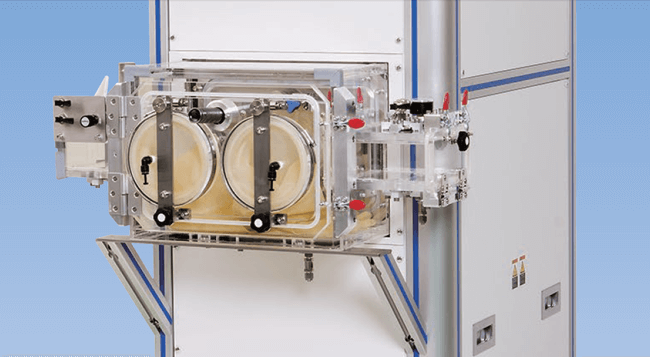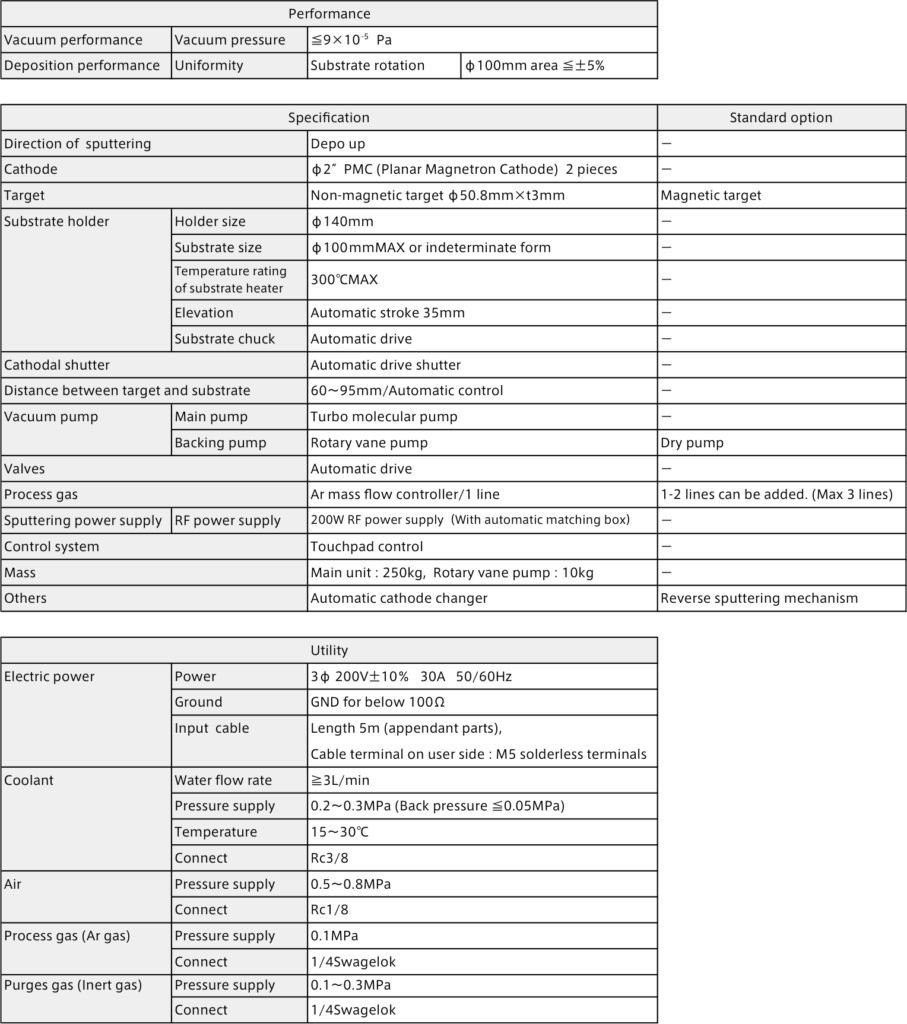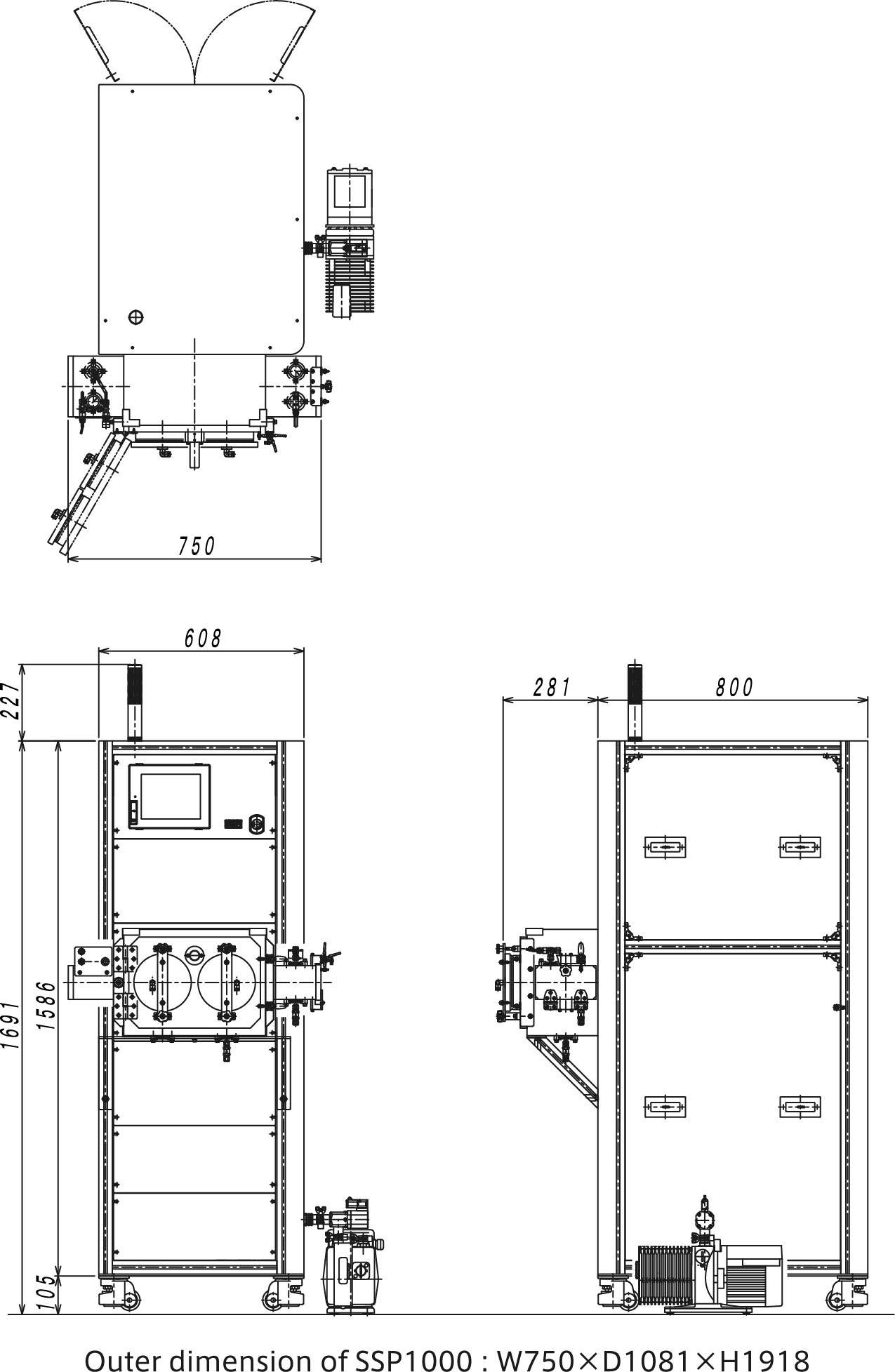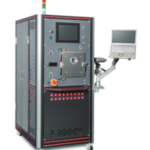
Sputtering system is deposition equipment using the sputtering method, which is classified as a physical vapor deposition (PVD) method within the category of vacuum thin film formation.
Thin films produced by sputtering equipment feature excellent adhesion to substrates, high reproducibility when repeatedly depositing films, and the ability to produce materials and alloys with high melting points. In addition, it can produce oxide and nitride films as well as metal films and insulating films, which are indispensable for functional materials such as semiconductors and electronic devices.
We possesses the technology and strict quality standards that we have developed over many years as a subcontractor to major vacuum equipment manufacturers. By applying this to our own brand of equipment, we can offer a user-friendly and robust high quality sputtering equipment, reflecting the needs of our customers.
[Characteristics of sputtering methods]
- The high collision energy of the material impacting the substrate results in a thin film with high adhesion strength.
- In the sputtering method, the material flies linearly in a fixed direction, so there is less film adhesion to non-substrate surfaces than with other deposition methods. However, it is difficult for the film to adhere to the sidewalls of uneven surfaces.
- Easy control of film thickness by adjusting various conditions such as supplying power and deposition time.
- A film of uniform thickness can be produced over a large area.
- High-melting-point materials and insulating films can also be deposited.
- Changes in the composition of the material are less likely to occur when making alloys, compared to evaporation systems which melt materials at high temperatures.
- Reactive sputtering combining nitrogen, oxygen, hydrogen, etc. can also be used for compound deposition l.
- Plasma cleaning (reverse sputtering) of the substrate deposition surface is also possible by applying high voltage to the substrate holder
- Lower deposition speed (deposition rate) than the evaporation method.
Contents
Product information on our sputtering system [SSP2500G].
The SSP2500G is a sputtering system for research and development.
It is used for R&D applications such as metal films, insulating films, conductive films, insulating films, protective films, reflective films, catalysts, coatings, circuits, batteries, MEMS and new materials development.
Equipped with a simplified glove box for both vacuum and gas displacement, the system can be used safely for deposition with anaerobic targets and substrate samples.
[characteristic 1] 2way cathode
Equipped with two 2-inch diameter magnetron cathodes (with shutters), with a film thickness distribution of ±5% or less within φ100 mm.
By switching the discharging cathode, this equipment can also be used for layered deposition.
[characteristic 2] Simplified glove box

Equipped with a simple glove box (made of acrylic resin) that can be vacuum-replaced, allowing substrates to be replaced and targets to be removed and attached without exposure to atmospheric moisture or oxygen.
Both the glovebox and the pass box can be vacuumed and replaced with nitrogen gas.
A gas inlet and exhaust control valves, pressure gauge, check valve and torchlight are included.
[characteristic 3] RF power supply with auto-matcher function.
The 13.56MHz 200W RF power supply made in Japan is equipped with an auto-matching function as standard so that fine adjustments are made automatically during plasma discharge.
Only the SSP2500G is equipped with an auto-matcher as standard specification among our SSP series.
However, the RF power supply of the unit is not equipped with a pulse oscillation function.
[characteristic 4] Touch screen program for easy operation

The program uses a GUI (Graphical User Interface) system that can be understood intuitively by the operator, and combines visibility regarding various statuses, including operating status, with operability that allows easy adjustment of valves and setting items.
It supports a fully automatic deposition process linked to an auto-matcher and can store up to 10 recipes.
During the process, status messages make it easy to determine the status of the equipment.
The program also includes a control program for the rate of power rise to prevent cracking of the target.
Other features include various interlocks, alarm functions and a function to note which type of target is attached to target number 1 and 2, making this touch-screen program both easy to operate and safe.
The program itself is designed to be easily modified to reduce design costs when changing the program in response to changes in research content or equipment modifications.
[characteristic 5] Slim tower design to reduce width
The deposition chamber, vacuum system and control system are combined into one tower with an overall width of 750 mm.
Compared to equipment with a separate main unit and control rack, the rear of the equipment has a cleaner appearance with no excess wiring exposed.
It can be easily moved when relocating or changing room layouts after installation, thus reducing man-hours (=expenditures).
Standard specifications for AGUS sputtering equipment [SSP2500G].
【SSP2500G Specification】

【SSP2500G Outer dimension】

Options for our sputtering system [SSP2500G]
①magnetic deposition
When depositing films with magnetic materials such as iron (Fe), a stable plasma discharge cannot be achieved with standard magnetron cathodes.
This option allows a choice of cathode specifications for magnetic materials.
Even after the installation, both magnetic and non-magnetic materials can be used by replacing parts.
②capability for thin targets
Our cathodes are ø50.8 mm x t3 mm geometry as the standard, but manufacturing a 3 mm thick target of expensive material can result in high expenditure.
If you want to reduce target expenditure or already know from the outset that the number of depositions will be small, shields and target holders for thin targets such as 1 mm and 2 mm are available. Please contact us if you are concerned about the cost of the target you are using.
※Some materials are difficult to discharge on thin targets.
※Note that if a thin target is sputtered in combination with the standard parts for 3 mm thickness, an abnormal discharge may occur in the extra gap created between the target and the shield, and deposition may not be achieved.
③reverse sputtering mechanism
The addition of a reverse sputtering mechanism makes it possible to remove oxide films on the substrate surface as a pre-treatment for deposition and clean the surface.
④additional gas introduction systems
Two additional process gas introduction systems can be added, making a maximum of three systems.
This option is required when performing reactive sputtering by introducing oxygen, nitrogen, etc.
⑤Up-grade to a dry pump

The auxiliary pump can be replaced from a rotary pump to a dry pump.
Basically dry pumps are required under the condition of cleanroom installation
Our selection of non-contacting, multi-stage Roots dry pumps ensures maintenance-free, clean exhaust air for a long time after installation.
Repair and modification of our sputtering system [SSP2500G].
Even after the equipment is installed, we are fully prepared to meet any request.
For more information, please contact us.
[Example of repair and maintenance menu]
- Periodical maintenance and service response in case of malfunction
- Modification or adding functions to equipment and the software update associated with such change
- Relocation of equipment and layout changes
- Operational training (e.g. when the person in charge of operations is replaced)
- Purchase of consumables
- Cleaning and re-blasting of the film on shielded components
- Questions to be answered by email, telephone, etc.
[Modification]
Even after the equipment has been installed, we can also provide services related to modifications due to changes in the content of experiments or conditions of use.
[Examples of modification]
- Combined with another device via a transfer unit (Plus series)
- Various functional additions/changes and parts replacement
- Production of sample holders for special shapes
- Program improvements and updates
- Additional gas introduction systems
- Replacement of rotary pumps with dry pumps
- Larger auxiliary pumps
- Additional cooling water circulator (chiller)





